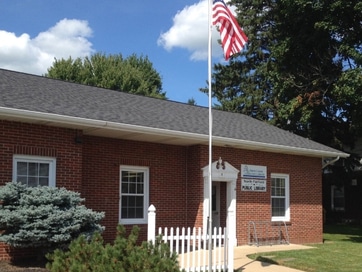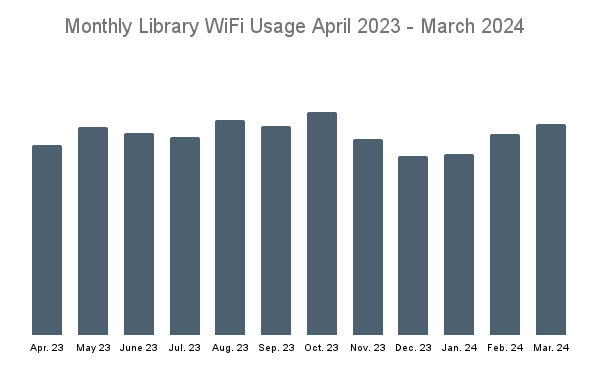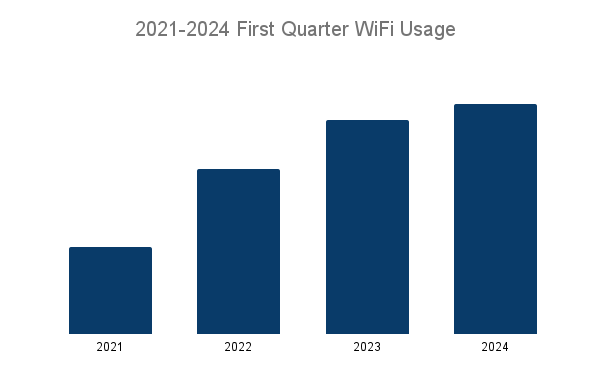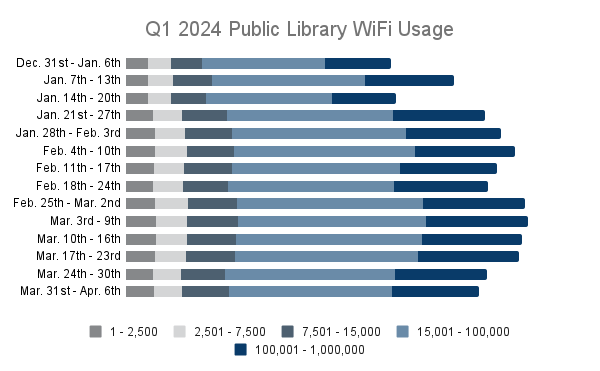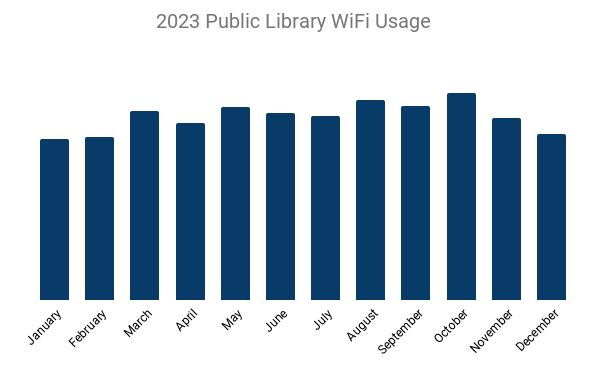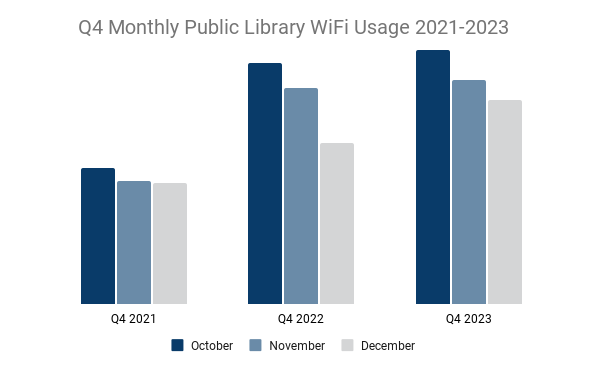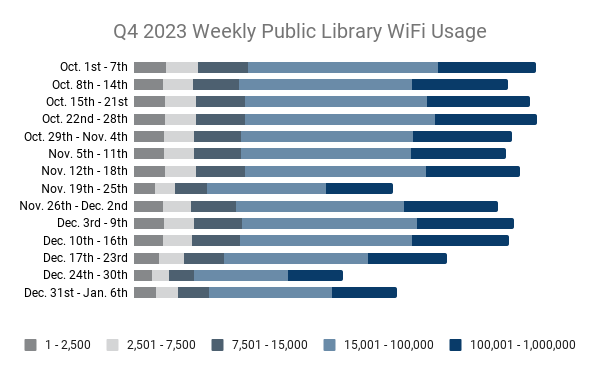Partner Feedback Shapes 9 Community Calendar Product Updates
At WhoFi, we work closely with our partner libraries to understand their needs and challenges. Each of these product updates were released over the last three months in response to feedback from libraries looking for better ways to streamline their operations and improve patron experiences. Let's take a closer look at the challenges our partners faced and the benefits they are now enjoying with these enhancements.
https://youtu.be/MhAGhzRttkQ
1. Automated Waitlists: Tackling Registration Challenges
Challenge:
Libraries had to manually move patrons from the waitlist to the attendees list when cancellations occurred.
Solution:
With automated waitlists, patrons are seamlessly moved from the waitlist to the registered list as cancellations happen, without any manual intervention. This update saves staff time and ensures every event is fully booked, without the hassle of manual adjustments.
2. Bottleneck Alerts: Avoiding Waitlist Issues
Challenge:
Automated waitlists sometimes resulted in bottlenecks when large groups on the waitlist could not be accommodated due to limited available seats. This created a “bottleneck” where despite the fact the event was not full no one could move from the waitlist due to the larger party.
Solution:
Now, with bottleneck alerts, libraries are notified when these situations arise, allowing them to take quick action. This helps prevent confusion among patrons and ensures every event has as many attendees as possible.
3. Collecting Patron Information Per Attendee: Enhancing Event Preparation
Challenge:
For events that required specific information, such as t-shirt sizes or food allergies, libraries struggled to gather details for each attendee when only the total number of participants was greater than one. This caused potential issues in planning and preparation.
Solution:
Libraries can now collect detailed information per attendee during registration, ensuring they are well-prepared for every event. This update enables a more personalized and organized approach to event preparation.
4. Add to Calendar: Streamlining Patron Engagement
Challenge:
Patrons wanted an easy way to add library events to their personal calendars, but without a built-in option, they often missed out on upcoming events and opportunities for engagement.
Solution:
The new "Add to Calendar" feature allows patrons to sync events with their Google Calendar or via an ICS file. This ensures they don't miss important events and keeps them engaged with library programs.
5. Quick Links for Faster Event Management: Saving Staff Time
Challenge:
Reviewing event details was a bit of a task, often requiring partners to navigate through multiple screens to preview events, view registration lists, or see who made changes to an event.
Solution:
With Quick Links, librarians can now instantly preview events, manage registrations, and access activity logs with just one click. This simplifies the process, saves time, and improves efficiency when managing events.
6. Cloning One-Time and Recurring Events: Reducing Repetitive Tasks
Challenge:
Libraries often needed to recreate similar events multiple times, which meant duplicating work, especially for recurring programs. This made event management unnecessarily time-consuming.
Solution:
The ability to clone both one-time and recurring events saves time by allowing staff to duplicate events with a single click. This feature streamlines the event creation process, reduces repetitive tasks, and increases efficiency.
7. Adjusting Attendee Numbers: Providing Flexibility for Patrons
Challenge:
Libraries found that patrons often needed to adjust the number of attendees after registration, but without a way to do so, it led to confusion and inaccuracies in event planning.
Solution:
Now, patrons can easily adjust their total number of attendees after registration, providing flexibility and reducing errors in event planning. This ensures that libraries have accurate headcounts for better event preparation.
8. Canceling Events and Notifying Patrons: Simplifying Communication
Challenge:
When events needed to be canceled, libraries did not have an easy way of efficiently notifying registered patrons and clearly marking events as canceled in their records.
Solution:
With this update, canceling events now automatically notifies all registered patrons and flags the event as canceled, simplifying communication and ensuring no one is left in the dark. This helps libraries maintain a professional and organized event management system.
9. Room Assignment Icons in the Archive: Improving Event Organization
Challenge:
Libraries had difficulty keeping track of which events had rooms assigned and which did not, leading to potential confusion and scheduling conflicts.
Solution:
New icons in the event archive now make it easy to see at a glance which events have rooms assigned and which do not. This quick reference helps staff stay organized and reduces the chances of scheduling mishaps.
With these nine product updates, WhoFi hopes to continue helping our library partners provide the best possible experience for their patrons. If you have any questions about these updates or any other WhoFi feature, feel free to reach out at support@whofi.com.If you would like to learn more about becoming a WhoFi partner please visit WhoFi.com/demo to book a meeting.
WhoFi and Wowbrary Integration Update
Supporting Libraries with Program Promotion
At WhoFi, we strive to help community spaces thrive. One challenge library partners describe is letting members of the community know about the amazing programs happening at the library.
Our tools support libraries in managing and sharing events with the community through Community Calendar, designed based on library feedback to simplify the process of planning, and promoting programs. By making it easier to showcase upcoming events, we ensure that libraries can reach more patrons.
Wowbrary Integration
Now, we’re excited to expand our support with a new integration with Wowbrary, a paid service that delivers a weekly library newsletter to patrons highlighting services. In addition to promoting events on the library website and social media with WhoFi, this integration offers another convenient way for libraries to share new programs and resources with the community. With Wowbrary, your events can now appear directly alongside newly added materials in newsletters, automatically shared with patrons each week.
Why Integrate WhoFi with Wowbrary?
Integrating Community Calendar with Wowbrary takes the hassle of duplicating efforts. Some library are taking time contacting patrons every week about new programs that are already on your calendar. Events and new materials are automatically added requiring no additional effort. This integration allows libraries to reach patrons more consistently and aids in maintaining engagement with programs and new additions to the collection.
Contact Us
Integrating WhoFi’s Community Calendar with the Wowbrary library newsletter service is easy. Simply contact us at support@whofi.com and ask to enable the Wowbrary feature. We’ll send you the steps for adding your calendar events easily in the Wowbrary newsletters.
If you are interested in getting started with Wowbrary, reach out to their team at info@wowbrary.com and they will be happy to help.
https://www.youtube.com/watch?v=E8BCT2E1cok
5 Ways to Fail at Promoting Library Events (and How to Avoid Them)
If keeping attendance low at the programs your library provides is a priority this piece is for you. Promoting library events can sometimes feel like an uphill battle. But what if we took a look at things from the other side? Here are five sure-fire ways to fail at promoting your library programs, and of course, some tips on how to avoid these pitfalls using modern techniques.
1. Print Only
Restrict the ways patrons become aware of events at the library to flyers handed out or hanging in the library. This will help to ensure some of the smallest amount of your community becomes aware and remembers the upcoming program. If your primary method of promoting programs happens to be through paper flyers you are well on your way to having your program fail.
Opposite: Those libraries that embrace digital marketing are not helping themselves fail! That’s right. Those that use their library’s website, social media, and email newsletters to spread the word about programs help ensure maximum reach to community members and beyond that may be interested in attending. Do not be tempted to try these methods for promoting library events even though library management services like WhoFi have made them easy to deploy because remember the goal is to fail, not succeed.
2. Manual Registration
Limit program registrations to in person or over the phone options. This process ensures that staff time is devoted to helping patrons sign up and taking away time from more meaningful interactions with the community. Further it creates barriers to allowing patrons to register at their leisure. Creating obstacles to patron registration and additional non strategic work for staff will help ensure programming failure.
Opposite: Those libraries that provide additional ways to register for upcoming programs including online registration from library websites and/or social media platforms are not helping themselves fail. Those that use software that allows patrons to sign up for events from the comfort of their homes, reduces the burden on the staff, and provides a more patron friendly way to sign up have made the task of failing that much harder.
3. Keep it in the Library
Keep the advertising efforts to the library audience exclusively helps programming fail. By not communicating the library’s programs outside the library community you can help ensure failure. Advertising only within the library limits your audience exclusively to those already using your services.
Opposite: Those libraries that expand their promotional efforts beyond the library walls will reduce their chance of failure. Some examples include partnering with local businesses, schools, and community organizations to spread the word about their programs. The use of social media and community calendars to reach a broader audience also has the ability to make them more successful.
4. Don't Elaborate
The use of vague program descriptions also helps lead to failure. "Join us for a fun event!" might sound inviting, but it’s not very informative. Bingo! Vague descriptions leave potential attendees confused and uninterested. When this happens they are less likely to want to show up and helps move us closer to our goal.
Opposite: Those libraries that are specific and engaging in their event descriptions reduce the likelihood of failure. Providing clear details about what the event entails, who it’s for, and why it’s worth attending is an absolute no. When patrons know exactly what to expect and can get excited about the program they are more likely to attend making it that much harder to fail.
5. Forget Reminders
Libraries that do not send reminders and follow ups to patrons that register for events provide a path to failure. Winning. Patrons' lead very hectic lives. They may sign up for a program and even place it on their daily planner but they are still likely to forget without reminders. By not making it easy for them to remember the program is taking place it will increase the likelihood of program failure.
Opposite: Libraries that send out confirmation and reminder emails increase the likelihood that patrons will attend the programs being held. Bonus. Follow-up emails to thank attendees, gather feedback, and inform them about upcoming events increases the likelihood of future program success. This not only shows appreciation but also helps you improve future programs and keep the community engaged. This is however about helping you fail so please do not look to incorporate these into your regular process.
Working to help library programming fail is no easy task. You may also think that doing the opposite is just as hard. This is no longer the case. Library membership management services like WhoFi help streamline the processes for promoting library events and reporting on their success. At WhoFi, we offer all-in-one library membership management tools. Some of these tools were specifically designed to help libraries reduce the burdens encountered during the planning, promotion, scheduling, and reporting of the many wonderful events taking place at the library. Schedule a meeting with us today to see how we can help your library succeed!
https://youtu.be/Suytj36OjvE
Second Quarter 2024 Public Library WiFi Utilization Trends
The second quarter of 2024 highlighted the ongoing importance of public library WiFi in promoting digital equity. There was a slight increase in WiFi utilization from the first to the second quarter, alongside a 7% year-over-year increase compared to the second quarter of 2023. This steady growth underlines the essential role libraries play in providing internet access. This analysis explores the latest data, revealing how libraries adapt to meet community needs through reliable internet and engaging programs.
Spring & Summer 2024 WiFi Utilization and Travel Trends
During the second quarter of 2024, public library WiFi usage experienced steady growth. This increase, although modest, reflects the sustained demand for internet access as the summer season began. Notably, there were typical summer lulls during the weeks of Memorial Day and the Fourth of July, as patrons engaged in holiday activities and travel. Despite these decreases, WiFi usage in other areas remained high, likely due to the variety of in-person programs libraries offered. These programs drew patrons to libraries, helping to offset the impact of seasonal travel trends and ensuring that libraries remained vital access points for information and digital resources.
FCC’s Ruling on Library Hotspot Lending
In June 2024, the FCC began discussing a significant decision to support E-rate funding for WiFi hotspot lending by schools and libraries. This decision, made official in July, enables libraries to apply for E-rate funds to offset the costs of providing hotspots and internet services to patrons for off-premises use. Building on the success of the Emergency Connectivity Fund (ECF) program, which provided critical internet access during the pandemic, the FCC's new ruling ensures ongoing support for libraries in offering essential connectivity to underserved communities. This initiative reinforces libraries' roles as digital equity advocates and crucial community anchors (SHLB Coalition) (SHLB Coalition).
Potential Impact of Summer Reading
The start of summer reading programs in the second quarter of 2024 played a crucial role in maintaining high WiFi utilization levels, despite increased travel activities. These programs not only promote literacy but also draw patrons to libraries, providing them with reliable internet access. The engaging nature of these programs ensures that libraries continue to serve as essential community centers for learning and digital engagement. The sustained usage during this period highlights the importance of public libraries in fostering digital literacy and connectivity, particularly during the summer months when other activities might otherwise reduce library attendance.
What Does the Future Hold for Public Library WiFi?
The second quarter of 2024 reaffirmed the crucial role of public libraries in promoting digital equity. With the FCC's new ruling on hotspot lending, libraries are better equipped to extend connectivity beyond their walls, reaching more patrons in need. As libraries continue to collaborate with state and federal authorities to leverage funding opportunities, they are poised to play an even more significant role in bridging the digital divide. The combination of innovative programs and expanded library WiFi access ensures libraries will remain key players in fostering digital literacy and connectivity for all.
Summary of Q2 Public Library WiFi Trends
- Sustained WiFi Usage: Slight increase from Q1 to Q2, with a 7% year-over-year growth.
- Summer Trends: Typical lulls during Memorial Day and the Fourth of July due to holiday activities and travel.
- Program Impact: High usage maintained by engaging in-person programs and summer reading initiatives.
- FCC Ruling: New E-rate funding supports hotspot lending, enhancing library connectivity for underserved communities.
To learn more about how WhoFi helps states and individual libraries spend less time gathering data and allows for more time to use it visit us at whofi.com/demo.
Why libraries use automatic reminder emails for event & room reservations.
Libraries are vital community hubs, offering spaces for events, study sessions, and meetings. Managing these spaces effectively is crucial to maximizing their usage and benefits. Automated reminder emails for event and room reservations can significantly enhance this process by addressing specific challenges faced by both patrons and library staff.
Challenges Without Automatic Event Reminders
-
Patron-Related Challenges
- Lack of Awareness: Without reminders, patrons might not remember all the details of their bookings or upcoming library events, leading to no-shows and underutilized spaces.
-
Operational Challenges
- Manual Reservation Management: Handling reservations via phone or paper can be time-consuming and prone to errors, such as double bookings.
- Resource Underutilization: Low attendance due to forgotten reservations results in wasted space and missed opportunities for community engagement.
Benefits of Implementing a Reminder Email for Event and Room Reservations
-
Increased Attendance and Participation
- Timely Notifications: Automated reminders ensure patrons are informed about their upcoming reservations and events, increasing attendance and reducing no-shows.
-
Enhanced Operational Efficiency
- Streamlined Booking Process: Automated systems reduce the administrative burden on library staff, allowing them to focus on other important tasks.
-
Improved Community Engagement
- Stronger Connections: Regular attendance fosters a sense of community, with patrons more likely to participate in library activities and programs.
WhoFi's Event and Spaces Reservation Reminder Features
WhoFi’s Spaces and Community Calendar tools simplifies the reservation, program registration, and the email reminder process for both patrons and library staff by providing several key benefits:
-
Visibility and Accessibility
- Online Reservations: Patrons can easily view upcoming events and room availability then submit reservation requests through the library’s website, reducing the need for phone or in-person bookings.
- Real-Time Updates: The system provides real-time updates, preventing scheduling conflicts and ensuring seamless integration with library programs in Community Calendar.
-
Automated Solutions
- Reminders &
Reservation Confirmations: Patrons receive confirmation emails along with reminders as their reservation or program date approaches, ensuring they remember their bookings.
- Efficiency: This automation reduces the manual workload for library staff and ensures patrons are well-informed.
- Reminders &
-
Comprehensive Reporting
- Usage Tracking: The system captures all reservation and registration details, enabling libraries to generate reports for board and state reporting effortlessly.
- Impact Stories: On-demand reports help libraries quantify and share the impact of their spaces with stakeholders, showcasing the value provided to the community.
Implementing automatic reminder emails for programs and room reservations can significantly enhance the efficiency and effectiveness of library operations. By addressing the challenges of manual reservations, libraries can boost attendance, maximize utilization, and foster community engagement. Leveraging tools like WhoFi’s Spaces & Community Calendar streamlines these processes, ensuring a seamless and positive experience for both patrons and library staff.
For more information on how WhoFi’s all-in-one suite of services can benefit your library specifically, please schedule a call. Visit whofi.com/demo to book a meeting.
https://youtu.be/yLrACSDZtK0
3 Innovative Library Summer Reading Ideas
Summer reading programs have long been a staple of libraries, offering a fun and educational way for patrons of all ages to stay engaged during the summer months. This year, we found 3 summer reading ideas from libraries that we had to share. Hopefully they can help to attract more participants and make these programs even more exciting this season.
Fresh Approaches to Summer Reading
Libraries are adopting new methods to make summer reading programs more appealing and accessible. Instead of traditional reading challenges, many libraries are allowing participants to set their own reading goals and are including a variety of activities beyond just reading. This flexibility helps cater to diverse interests and schedules, and makes it easier for more community members to join in.
Balancing Community and Staff Needs
A successful summer reading program balances the needs of the community with the capacity of library staff. By leveraging tools like community calendars and meeting room management systems, libraries can streamline planning and execution. This helps to ensure programs are sustainable and impactful without overburdening staff.
3 Innovative Summer Reading Ideas
Libraries are incorporating a wide range of activities to attract and engage participants. Many of these ideas come from librarians sharing their experiences and suggestions on r/Libraries and r/Librarians on Reddit:
1. One-Hour Events: Short, engaging activities can draw in attendees who might not have time for longer commitments. Some popular ideas include:
- Geocaching: A modern-day treasure hunt that encourages participants to explore their local area and discover hidden caches.
- Campfire Story Times: Evening events where participants gather around a (real or artificial) campfire to share and listen to stories, fostering a sense of community and adventure.
- Book-Themed Crafts: Creative sessions where participants can make crafts related to their favorite books, combining art with literature.
2. Targeted Programs: Tailoring programs for different age groups ensures that there is something for everyone, not just children. Examples include:
- Teen Book Clubs: Offering a space for teenagers to discuss their favorite books and explore new genres together.
- Adult Reading Challenges: Programs specifically designed for adult readers, such as themed reading lists and social gatherings to discuss books over coffee.
3. Community Partnerships: Collaborating with local organizations can provide additional resources and help reach a broader audience, offering more varied experiences. Some successful partnerships include:
- Local Parks and Recreation Departments: Partnering to offer outdoor reading events and nature walks that combine physical activity with literary exploration.
- Schools and Educational Institutions: Working together to promote summer reading and provide educational workshops and activities.
Evaluating and Improving Programs
To continually improve summer reading programs, libraries are setting specific, measurable goals and collecting data on participation and feedback. This allows them to refine their offerings and demonstrate the impact on participants' reading habits and skills.
Enhancing Engagement with Technology
Modern tools are playing a crucial role in enhancing the effectiveness of summer reading programs:
- Community Calendar: A community calendar helps libraries manage and promote events efficiently, gather registrations, and report on their success. This ensures that patrons are well-informed about upcoming activities and can easily participate as well as making it easy to share results with board members and the state.
- Meeting Room Management: Efficient meeting room management ensures that spaces are utilized optimally and avoids scheduling conflicts. Many libraries are supporting a variety of programs and workshops that complement the reading challenges, so avoiding double bookings is especially important during this busy season.
Libraries are successfully revitalizing their summer reading programs by adopting flexible, inclusive approaches and leveraging modern tools to enhance engagement and efficiency. These efforts not only make summer reading more accessible and enjoyable but also strengthen the library's role as a vibrant community hub.
By continuously innovating and improving, libraries can ensure that their summer reading programs remain a beloved tradition. A tradition that brings communities together, and fosters a love of reading in patrons of all ages. If you would like to connect to review how WhoFi's all-in-one suite of services could help simplify library management across the board, we would like to meet. Visit WhoFi.com/demo or email us directly at marketing@whofi.com to schedule a meeting.
https://youtu.be/wGVz-UYAu48
New Library Staff Training Strategies
It can be daunting for new library staff members facing the challenge of learning their roles while understanding the intricacies of library operations. Library staff training often presents obstacles, including communication gaps, time constraints, and documentation issues. That said, a great team with a quality onboarding process can reduce burdens and make taking on a new role less intimidating.
Clear communication, record-keeping, and continuous support are essential elements of successful onboarding. However, libraries sometimes struggle with these aspects due to limited resources and staff time. In this post we’ll explore the challenges associated with onboarding new library staff, share insights from research and interviews with librarians, and discuss how libraries can relieve some burdens utilizing easy to use reporting services such as WhoFi.
Challenges in Onboarding Library Staff
Onboarding new staff members in a library setting presents a unique set of challenges that can impact the efficiency and effectiveness of library operations.
- Communication Gaps
One of the primary challenges in onboarding new library staff is the presence of communication gaps especially when previous staff is not available for training. Libraries may struggle to effectively convey essential information to new hires, leading to confusion and inefficiency. This can be especially problematic in libraries with a smaller staff or high staff turnover rates.
- Time Constraints
Time constraints pose another significant challenge in the onboarding process. Libraries often operate with limited resources and personnel, making it difficult to dedicate sufficient time and attention to properly onboard new staff members. This can result in rushed or incomplete onboarding experiences, hindering the success of new hires into the library team.
- Lack of Documentation
A lack of comprehensive documentation is another common challenge faced during the onboarding process. Libraries may not have had time to create a process to provide new staff members with access to essential resources, policies, and procedures, leading to incomplete understanding. Without proper documentation, new hires may find it challenging to navigate their roles effectively and start serving the community seamlessly.
Importance of Effective Onboarding Processes
Effective onboarding processes play a crucial role in ensuring the long-term success of new librarians and the overall efficiency of library operations. By prioritizing clear communication, documentation, and continuous support, libraries can create a positive onboarding experience that sets new staff members up for success.
- Setting New Hires Up for Success
Clear communication and documentation are essential for setting new hires up for success in their roles. By providing comprehensive information about library policies, procedures, and expectations, libraries can empower new staff members to navigate their roles effectively from day one. This not only boosts their confidence but also enhances their ability to contribute to the library's goals and objectives.
- Fostering a Sense of Belonging
Effective onboarding processes also play a crucial role in fostering a sense of belonging among new staff members. By providing continuous support and guidance, libraries can help new hires integrate into the library team seamlessly. Regular check-ins and opportunities for feedback create a supportive environment where new staff members feel valued and appreciated, enhancing their overall job satisfaction and retention.
- Enhancing Library Operations
In addition to supporting new staff members, effective onboarding processes also contribute to the overall efficiency of library operations. By ensuring that new hires are well-equipped with the necessary knowledge and resources, libraries can minimize disruptions and maintain continuity in service delivery. This ultimately enhances the library's ability to meet the needs of its patrons and achieve its organizational objectives.
To further understand the challenges associated with library staff training and the importance of effective onboarding processes, we explored insights from research articles and interviews conducted with library professionals.
Research Insights
A study conducted by the City University of New York (CUNY) sheds light on the challenges faced by new librarians during the onboarding process. The study emphasizes the importance of clear communication, documentation of institutional knowledge, and regular check-ins for new librarians to succeed in their roles. It highlights the need for library leadership to prioritize effective onboarding processes to ensure the long-term success of librarians. https://academicworks.cuny.edu/cgi/viewcontent.cgi?article=1638&context=qc_pubs
How it helped Huron
In an interview with Chris Mills, branch manager for the North Fairfield and Greenwich locations of Huron County Community Library in Ohio, we gain firsthand insights into the challenges of helping library staff adopt new solutions and the impact of easy to use programs for her library. Chris shared how communication gaps, time constraints, and adapting new technologies have historically hindered processes at the libraries she serves. However, with the implementation of WhoFi, they have streamlined tasks such as planning programs, gathering registration as well as attendance. This has made it easier for new and existing staff across the district to provide Chris the numbers she needs for the state survey.
From both research insights and interview perspectives, it's clear that effective onboarding processes and easy to use technology are crucial for the success of new librarians and the overall efficiency of library operations.
Simplifying Onboarding for Libraries with WhoFi
WhoFi can serve as a valuable ally for libraries seeking to streamline their onboarding processes and enhance efficiency. With its suite of services tailored specifically for libraries, WhoFi offers user-friendly tools for managing programs, reserving spaces, and more.
By simplifying these tasks and providing libraries with easy access to data and reporting tools, WhoFi empowers libraries to overcome lengthy training challenges with an easy to use service covering various library services. By spending time to create effective onboarding processes and leveraging solutions like WhoFi, libraries can ensure the long-term success of their staff and the overall efficiency of library operations.
Are you ready to streamline your library's onboarding processes and enhance efficiency for both current and new staff members? Reach out to us at marketing@whofi.com to book a meeting and explore how WhoFi can simplify tasks such as attendance tracking, program calendar management, and usage statistics reporting.
https://youtu.be/2CPZujv1ulU
Stable Public Library WiFi Utilization Trends in Q1 2024
The latest analysis of public library WiFi utilization in the first quarter of 2024 indicates a stable trend. This stability not only reflects the return of normalcy following pandemic conditions, but also the pivotal role libraries play for patrons. This quarter we will review observed trends, their potential implications, as well as upcoming digital equity grant opportunities from the NTIA.
Monthly Library WiFi Usage - April to March
Examining the data from April 2023 to March 2024 reveals a pattern of stability in usage on the monthly level. This sustained increase suggests a growing reliance on libraries for digital access. This underscores the critical role that libraries play in meeting the evolving needs of their patrons.
Furthermore, the impact of late 2023 usage trends appears to have been mitigated by milder weather conditions nationwide in December. This resilient usage of library WiFi services highlights their commitment to ensuring uninterrupted access to digital resources for patrons.
Comparing Results from Previous Years
A comparative analysis of WiFi usage trends reveals an intriguing shift in the first quarter of 2024. While previous years experienced exponential growth in usage following the pandemic, 2024 appears more stabilized. Going forward libraries will have a leading role in driving future growth. The sustained growth in WiFi usage reaffirms libraries' commitment to bridging the digital divide and underscores their significance as essential community resources.
Libraries continue to play a vital role in providing equitable access to digital resources. In fact, many have sought to partner with state broadband offices to take part in the digital equity act advancing digital equity across the country.
Opportunities for Libraries to Advance Digital Equity
In light of ongoing programs from the Digital Equity Act such as the current Digital Equity Capacity Grant Program, libraries have unique opportunities to contribute to the advancement of digital equity in the form of raising awareness in communities. The NTIA lists digital literacy training, cybersecurity training, and raising awareness of the availability and affordability of access to broadband technology as qualifying activities for this grant. Applications for grant funding are due by May 28, 2024. This grant could provide libraries with resources to enhance their current program offerings. For those interested in more information and how to get involved with their state’s digital equity plan, broadband offices for each state can be found at broadbandusa.ntis.doc.gov/resources/states.
Public Libraries serve as vital community anchors in bridging the digital divide. By leveraging available resources and partnerships, libraries can continue to empower individuals with access to essential digital services, ultimately fostering more inclusive and resilient communities.
Weekly WiFi Usage in Q1 2024
In looking at WiFi usage data weekly, obvious patterns such as lower usage on holidays become clear. The two holidays where decreases in usage occurred this quarter were New Years Day and Presidents Day.
By providing reliable WiFi access, libraries become essential for individuals who rely on digital resources for education, work, and communication. This sustained growth in WiFi usage underscores the enduring impact of libraries in providing equitable access to information and technology.
What Does the Future Hold for Public Library WiFi?
Looking ahead, public library WiFi will continue to be a critical component of library services for the community. Ongoing federal funding initiatives and collaborative continue efforts to expand broadband infrastructure. Going forward, libraries are poised to meet the evolving digital training needs of patrons and advance advocacy efforts.
As technology advances, libraries will remain steadfast in their commitment to providing access to digital resources and fostering digital literacy. By embracing innovation and collaboration, libraries will continue to serve as invaluable resources for their patrons.
To learn more about how WhoFi helps states and individual libraries spend less time gathering data and allows for more time to use it visit us at whofi.com/demo.
https://youtu.be/DAljvQS0NpM
5 Summer Reading Ideas for a Successful Season
Are you looking to create more successful and engaging summer programs for your patrons? It can be a challenge to keep returning patrons informed and attract new community members. And let's not forget managing resources and costs for big events. But don't worry, we're here to help! We've gathered proven summer reading ideas from libraries across the country to help make your summer programs a hit.
1. Get to Know Your Community's Interests: New Rochelle Public Library
Want to create a summer program that excites and brings your community together? Take a cue from the New Rochelle Public Library, who hosted a Summer Reading Kickoff Party that drew over 500 enthusiastic attendees. How did they do it? By asking their patrons what they wanted and delivering a program tailored to their interests. From fun photo ops with beloved book characters to engaging craft activities, they created an event that set the stage for a summer of reading excitement. Read more.
2. Amp Up Your Marketing Game: Pioneer Library System
When it comes to marketing your summer programs, consistent engagement with patrons is pivotal to program success. Take a page from Pioneer Library System's award-winning Summer Learning Challenge in 2022, which saw a 48% increase in registrations and a whopping 65% increase in completions from 2021 to 2022. How did they do it? By leveraging targeted marketing efforts and engaging their community every step of the way. From eye-catching social media posts to personalized email reminders, they spread the word and got people excited about learning. Read more.
3. Collaborate with Local Businesses: Carnegie Library of Pittsburgh
Collaboration is key when it comes to planning big summer events. Just look at the Carnegie Library of Pittsburgh’s post-summer reading celebration, where they teamed up with a variety of local businesses and organizations to host a family-friendly outdoor festival. From musical performances and craft activities to food trucks and storytelling sessions, they created an event that brought the community together in celebration of literacy and learning. By working together with their local business partners, they were able to create an unforgettable experience for attendees while maximizing resources and reaching a broader audience. Read more.
4. Embrace Technology: Hillsborough County Library
In Hillsborough County, libraries are using technology to promote summer reading among children and teens through the Beanstack app. More than 3,600 participants, including 11-year-old Joanna Binu, logged hundreds of hours of summer reading using the app last year. Beanstack allows users to track their reading hours, earn digital badges, and receive book recommendations based on their interests. By leveraging technology, libraries like Hillsborough County are making reading fun and accessible, even for the digital age. Read more.
5. Foster Community Engagement: Free Library of Philadelphia
The Free Library of Philadelphia is teaming up with other anchor institutions across the city to ensure that children and teens have the most fun possible this summer. Through initiatives like "It's A Summer Thing!", families can access a wide range of free or low-cost programs, including summer camps, swimming lessons, reading activities, and more. By collaborating with partners like Philadelphia Parks and Recreation and the Department of Human Services, the Free Library is creating a summer to remember for young people across the city. Read more.
We hope these summer reading ideas will benefit your library as you plan your summer programs for 2024. If you're looking for ways to spend more time planning and less time tracking attendance, WhoFi may be able to help. Click the demo button below to set a meeting and learn more about how we can simplify hosting summer events or email us at marketing@whofi.com. Happy Programming!
https://youtu.be/NQpeR7jROCA
Analysis of Public Library WiFi Usage in 2023
Public Library Insights for 2023
In 2023, public libraries continued to play a pivotal role in fostering digital equity and community engagement. Through collaborative efforts with programs like E-Rate and BEAD (Broadband Equity, Access, and Deployment), libraries served as essential hubs for connectivity empowering individuals with digital literacy training and expanding access to digital resources nationwide. Innovative library promotion strategies like leveraging social media and adding library calendars to websites, enabled libraries to enhance visibility and engage with patrons beyond physical boundaries of the library walls. Join us below as we review library insights from 2023.
In 2023 we witnessed a notable increase in library WiFi usage, driven by several potential factors. This year was the first year that no major cities were required to engage in lockdowns due to the COVID-19 pandemic. Libraries partnered with states to provide information about how to get connected to various programs making internet access affordable. Additionally, public libraries continued to provide essential digital literacy training with plans to expand during BEAD program implementation in many states. Innovative library promotion efforts, heightened library visibility and attracted patrons, contributing to the surge in patronage throughout the year. This expansion of digital infrastructure likely helped to improve usage. This will continue to make libraries central hubs for connectivity within communities.
Why seasonal changes looked different in Q4 2023
Seasonal changes in Q4 2023 looked different than Q4 2022, showcasing a smaller decline in usage during the traditionally low traffic period in December. It is possible that milder temperatures across the country in December 2023 played a role in reducing the seasonal decline. Casual library users in 2022 may have been more likely to wait for milder weather to visit the library. Sustained use of WiFi services throughout the year reinforces the importance of libraries in their communities even through holiday months.
Innovative Library Promotion
Libraries embraced innovative promotion strategies in 2023, leveraging services like TikTok and library calendar software to engage with patrons. This innovative approach resulted in increased visibility, with libraries gaining significant following and fostering digital engagement beyond physical spaces.
Library promotion is a wonderful tool to help librarians ensure they broadcast their offerings to the largest possible audience. By tapping into new avenues of communication and connection, libraries demonstrate adaptability and relevance for patrons of all ages. This further strengthens their role as essential sources of information and digital access.
Interpreting insights for 2024
The insights gleaned from library WiFi usage trends in 2023 provide valuable guidance for anticipating future developments. By staying responsive, keeping up with evolving community needs and leveraging innovative approaches, libraries are poised to continue their service as vital hubs of learning, connectivity, and community empowerment in 2024 and beyond.
The data is clear - libraries are essential players when it comes to providing internet access to under-served communities. According to the American Library Association (ALA), providing access to internet is particularly critical in areas that would otherwise have none.
Reviewing patrons' utilization of library services empowers staff to make data-driven decisions in community engagement. Insights from WiFi analytics remain useful for libraries as they strategize and advocate for future endeavors. If you would like to review how our solutions make gathering these insights easy please click the demo button in the top right of the page.





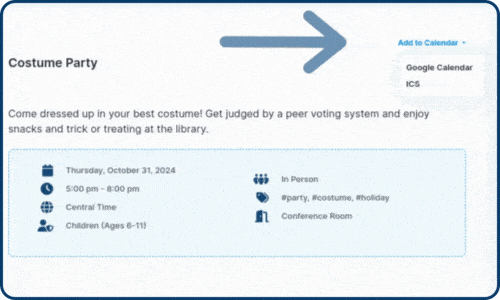
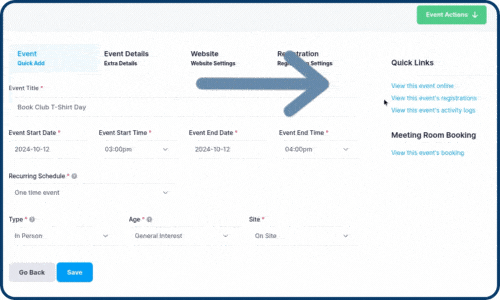

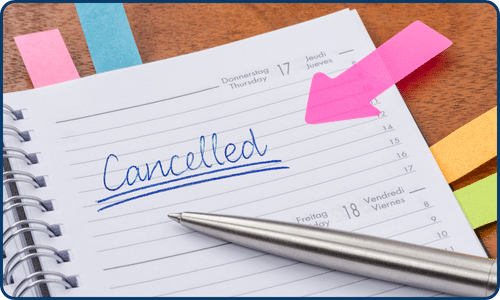






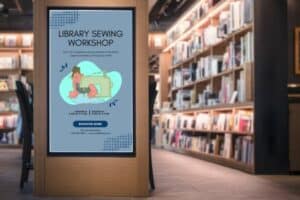


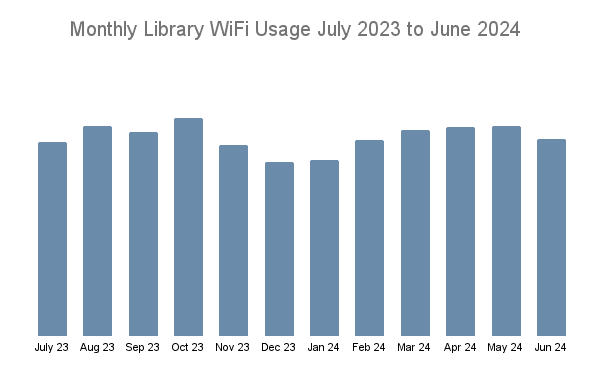
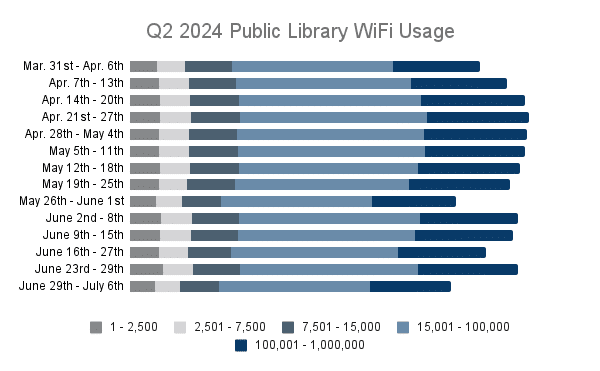
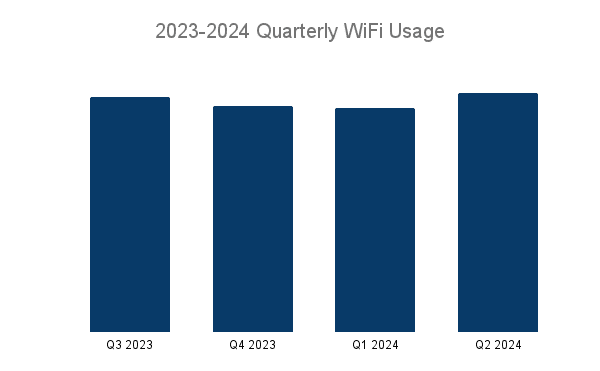




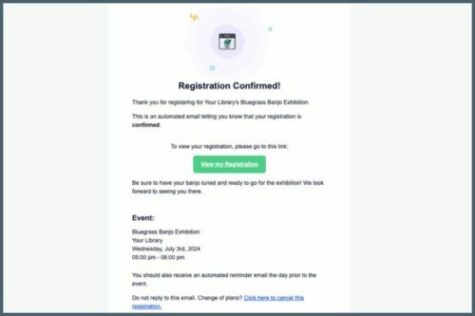 Reservation Confirmations
Reservation Confirmations





